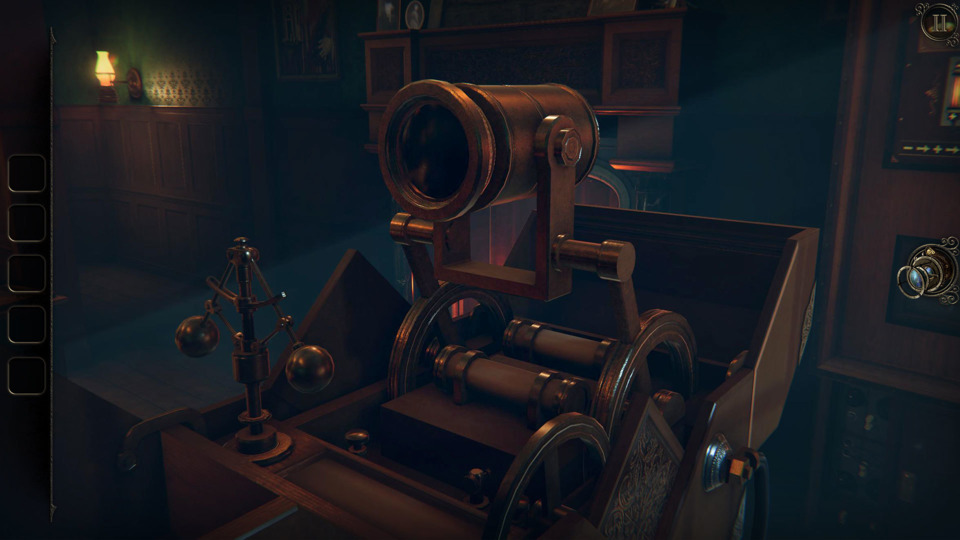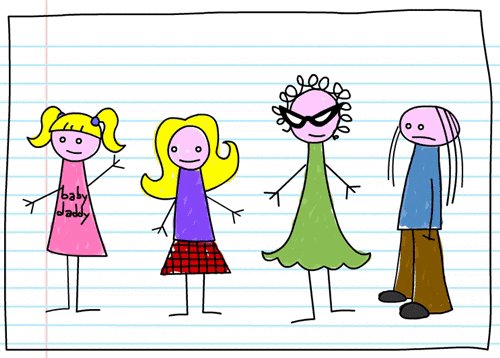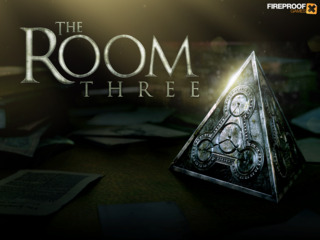
The Room Three: Lisa's Re-tear-apartening (maybe not a real subtitle) is the third episode in a series of adventure games that are part escape room and part tinkering with machines to see how they click. Each The Room has so far, invariably, involved exploring rooms in a vaguely early 19th century setting and looking over various devices of small and massive stature to see how they function, rotating and panning one's view of these objects to find panels, switches, wheels, catches, monitors, dials, and various other mechanical obstacles to overcome with simple gesture-based movements with the mouse (for the Steam version; the original iOS/Android versions have touchscreen support) or with the right item, usually procured from some other device that's maybe a room or two over. While the game started with a series of rooms, or The Rooms, it has expanded outwards to include several connected areas with a theme: this time, the theme is that each area of the game is a different part of the island laboratory Greyholm, and include a workshop, an observatory, a lighthouse, and others. Each of these areas comprise a single chapter destination, where the main building and its connected rooms act as a hub between these chapters. Everything is dictated through click and/or drag controls, from the manipulation of the devices to general movement through each area.

Unfortunately, The Room Three (or the PC version at least) makes the gravest error a puzzle game can: by breaking the implicit degree of trust that is formed with a game like this regarding its mechanics and progression. If something fails to activate, we accept that it is because we - the player - have yet to complete all the necessary steps. Likewise, it's the player who's at fault if their progress stalls because it means they've yet to figure out what it is they need to do next, and they can either stubbornly keep searching for a solution or give up and check the in-game hint system or an external walkthrough. Anyone playing a puzzle game accepts this. But when it's the game itself creating these roadblocks because the next piece of code failed to trigger - which occurred multiple times while playing The Room Three - the player can only assume that they are the one who has messed up, forcing them to try every possible button combination and double-click every hotspot in a futile attempt to move forward, and so it shatters this important bond of trust that makes it difficult to want to continue with the game. Or, at least, puts you in a position where it's preferable to abandon all semblance of an "honor system" by trying to solve the puzzles on your own and simply read what's ahead in case the current stalemate is due to another instance of the game's code shitting the bed. This process robs the game-playing experience of so much satisfaction that it becomes a shell of what it once was, simply because the developers hadn't done a thorough enough job of playtesting their port (though I will admit that having a less-than-adequate PC almost assuredly factors into this in ways the developer could not have anticipated; definite shades of how agonizingly unoptimized The Witness was despite its supposedly over-meticulous game director).
The issues don't stop there either. Anything that spins has a chance of spinning indefinitely, making it impossible to align it in whatever way it needs to be aligned in order to complete the attached puzzle. Anything driven by the mouse with a drag manuever is also sluggish and unresponsive, or overly responsive - pushing something twice as far as you meant to with the slightest of gestures - and this makes a lot of puzzles where you have to adjust dials to be "just so" much more challenging and irksome than it ought to be. There's a particular ballerina figurine puzzle where you have to hit a button several times as she trundles along a course in order to switch tracks - there's a specific part where she'll simply refuse to make the switch, no matter how close the timing is. The developers of the game, geniuses that they are, respond to the dozens of panicked comments from those unable to pass this section with "you're just not getting the timing right lol" as if it hadn't yet occurred to these players that the goal of this puzzle is to hit the button to make her change direction. This is despite the fact that, in this phase of the puzzle, you would have already changed tracks four or five times without incident. (I did eventually get past it myself, but only after turning every graphic setting to lowest/off and even then through about half an hour of stubborn repetition.)

I love this franchise for its clever puzzle design, its dedication to verisimilitude with its Edwardian period-accurate set dressing and making its gadgets and gizmos feel like real if improbable mechanisms, and the dopamine-releasing series of satisfying clacks and clicks as all its intricate machinery unwinds and unfolds and activates like it's supposed to, and deep down I still had a mostly good time with The Room Three despite the legion of game-breaking bugs - or if not breaking then at least temporarily halting, as resetting the game by quitting and reloading lead to most of the above puzzles working normally on a second attempt - but there's no denying just how much of a deleterious effect they've had on my overall enjoyment. Any masterpiece clockwork mechanism ceases to be impressive when it decides to stop working, and it's hard to win back the enthralling effect of that magic once it's been lost. I'm sure this will be a highly conditional thing that will be inapplicable to those playing the original iOS/Android versions of the game or to anyone with a half-decent PC rig, but ultimately I can only speak to how my own playthrough went and the ruinous effects that may or may not have befallen it. Grab it for your phone/tablet and give the Steam version a miss, is the only advice I can safely offer.
Rating: 3 out of 5.
| < Back to 133: Subnautica | The First 100 | > Forward to 135: Heroes of the Monkey Tavern |

Log in to comment